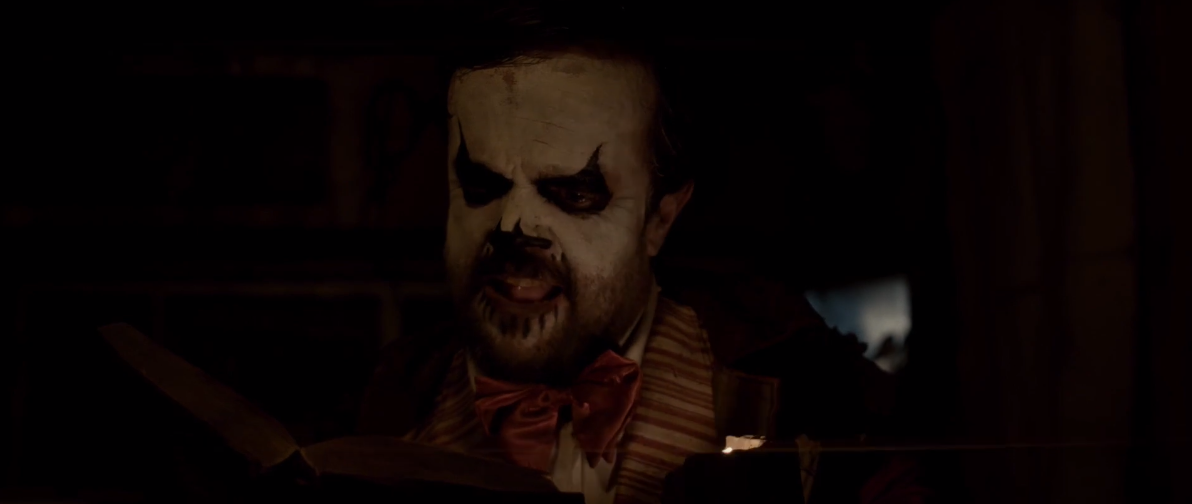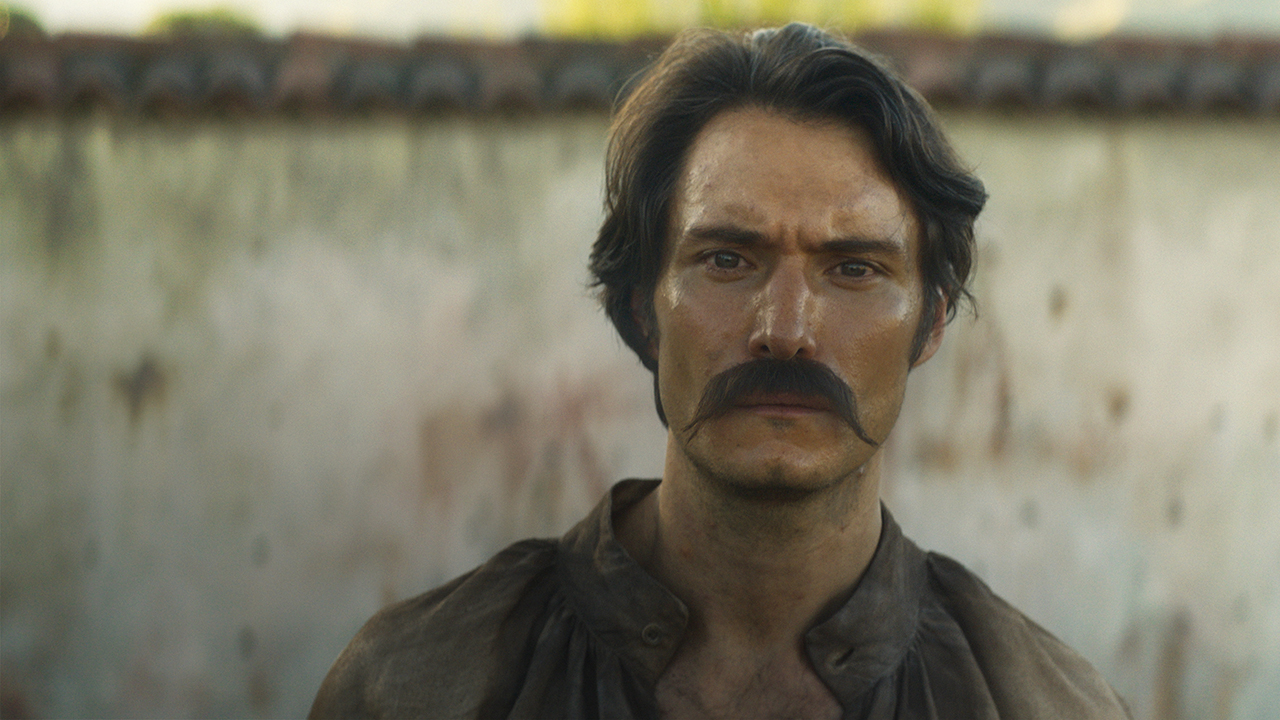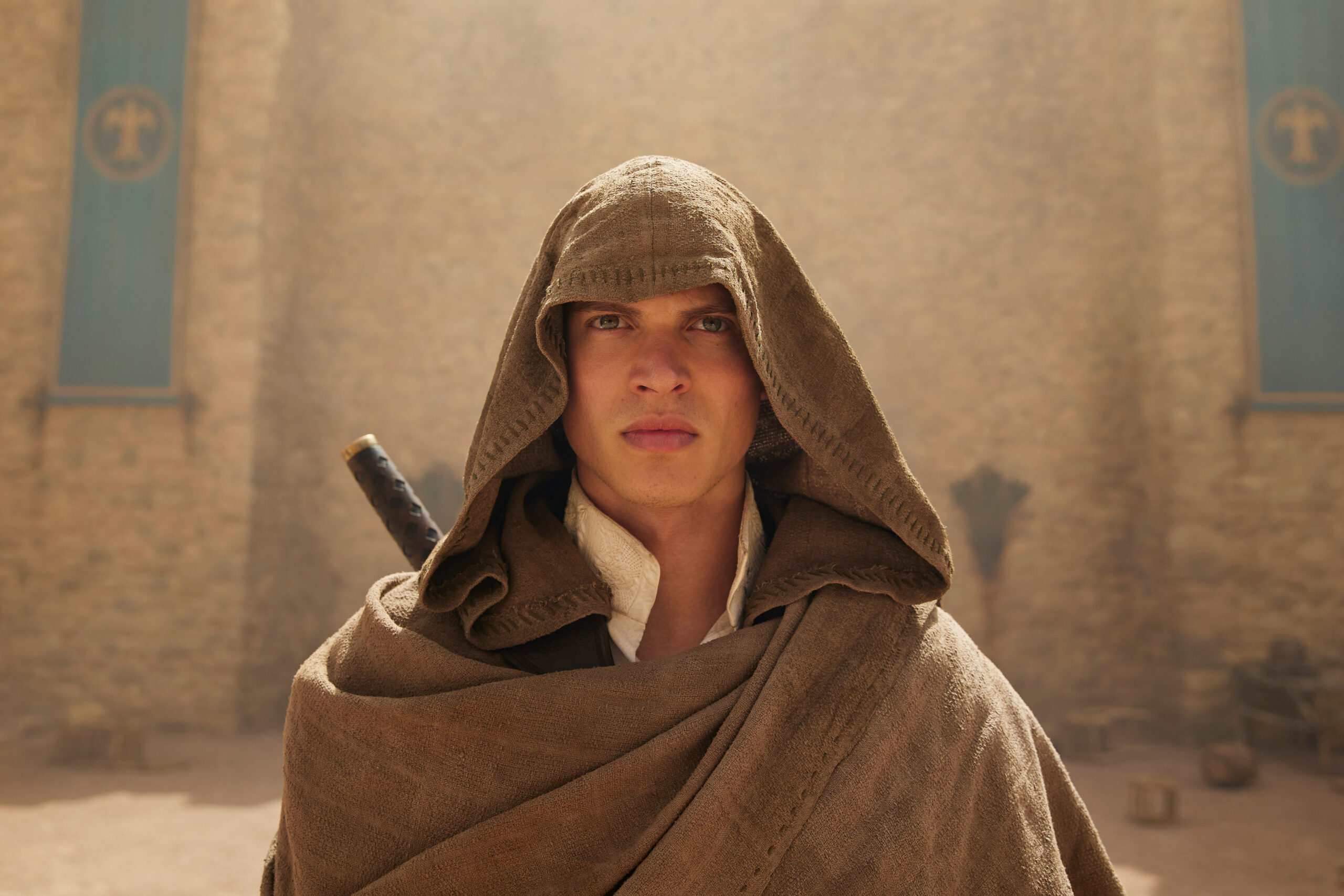
Josh Hasty has made three feature films, but he considers Candy Corn, his third, to be his first real movie. Boasting cameos by horror legends Tony Todd and P.J. Soles, it concerns a young man who is brought back from the dead to exact revenge on the bullies who killed him.
In this interview, we talk to Hasty about skipping out on film school, the small world of the horror filmmaking community and being a multitasking indie film director.
Below is the official synopsis for Candy Corn:
“It’s the eve of Halloween in Grove Hill, Ohio. A traveling carnival is in town for the weekend and local outcast, Jacob Atkins, has been hired as one of the freaks in the event’s main attraction, “Dr. Death’s Side Show Spook House Spectacular.” When a group of bullies target Jacob for their annual hazing, things go too far and he winds up dead. Now, Dr. Death has resurrected Jacob as an unstoppable killer to seek revenge on those who wronged him.”
Candy Corn is in select theaters today and hits VOD on September 17, 2019!
LRM Online: Thank you for taking the time to speak with me about your feature. I watched it last night to prep for this interview and I enjoyed it. Especially the great Halloween vibes.
Hasty: Awesome. Thank you.
LRM Online: I saw that you didn’t go to film school before you started filmmaking. I wonder if you could talk about that and if you feel like that’s in any way impeded you or if you thought it was freeing.
Hasty: I think it was a huge decision. You know, I’m from the Midwest, I’m from Ohio and it’s kind of a lofty idea to get into filmmaking in any capacity to make a living. And for me coming from that place, the only avenue seemed like film school. And so I learned as much as I could on my own building up to that all the way through high school and I got accepted to film school in New York. And it was pretty scary, the thought of doing that, but it was exciting at the same time.
And then I ended up meeting an alumni from there who was also from Ohio and I just happened to meet him at a baseball game and he told me, don’t do it. Take the money you’re going to waste on film school, go get a good camera, get a good editing software and just start shooting. Just learn everything you can on your own. Find your voice in filmmaking, and by the time your graduating class that you would be in is done, you’ll probably know more than they do or probably even have a film under your belt. It was still a decision after that, because I was super pumped to go to film school and it was scary. Like, all right, this guy says it, but he went to film school and he also has a full time job with MTV now. So it’s easy for him to say.
But yeah, I decided, I think that that does make sense for me. I mean, I was awful in regular school and just thinking about going there and sort of being taught a curriculum and having an agenda of things to do inside of a creative box just did not speak to me. And then, you know, this is pre-iPhone and Google. So it wasn’t like all this information was just there. So I would go to the library and look up books on my favorite filmmakers or get on the computer that was at the library and try to find articles. And I would find that more times than not, the filmmakers that I knew of, whether I loved them or not, they didn’t go to film school and they just did their own thing. And if they did go to film school, they dropped out quickly.
And I was just like, well maybe I can just figure this out. Maybe that’s advice I should take. And I tell everybody, I think it’s one of the greatest decisions I ever made because I know a lot of people that went to film school and there’s a place for it. I think, if you want to learn the technical side, you want to work on film sets or within the industry in a certain capacity, I think film school is really great for that. Because there are technical things you don’t need to know as a director that you do need to know if you want to be a great cinematographer or an editor. I’m sure you can eventually learn on your own, but the roadmap to success there would be exponentially longer than it would be if you just want to do what I did and am doing, which is write and direct.
And ultimately, I edited all of Candy Corn, every frame. I edit everything I’ve done and I had to learn that out of necessity as well. But ultimately, what I wanted to do and what I’m doing now, you can’t learn in a classroom. How could you? You don’t know where these ideas come from. It’s like David Lynch always says, directors are just a conduit and we don’t know where these ideas come from, but they come and you just take it, put it on the paper, and then turn it into film. And there’s no school that can teach that and definitely not at the price that they charge either. So, I’m very happy that I did it.
LRM Online: You’ve made a couple of features now, so that hasn’t held you back at all. You were talking about editing, and I noticed you weren’t just writing and directing this, you were also producing, editing, and you also had a hand in the music for Candy Corn as well. Is that correct?
Hasty: Oh yeah. I also did all the wardrobe with the exception of three wardrobes I didn’t do. But I made them all, I co-composed the score with a friend of mine, Michael Brooker. We did all of that. I did 99% of the foley myself. Fortunately, because of all the work that went into it, it doesn’t look as low budget as it really is, but I mean I did a lot. At the beginning, when we first started shooting, we had a crew of six people and I was literally getting lunch for everybody. Like running and getting food for the crew and the cast and then coming back and directing. And it was just a year and a half ago or two years ago now.
I did everything I had to do. And there’s some stuff I love to do. I love writing music, especially with Michael who I wrote it with. We’ve written music and played music together for almost 10 years now, and we never got to do it on a film project. This was our first opportunity to do that. But it was just amazing. And I plan on having a very prominent hand in the scores of all my projects moving forward. I love having a hand in wardrobe. I’m a huge, huge fan of that side of things. And obviously I can’t really imagine someone else doing the editing. But there’s other things that I had to do because they just had to be done and we didn’t have money to pay somebody to do it. I didn’t credit myself on most of the things I did because it would’ve just been obnoxious.
LRM Online: Your name would have been there like 30 times in the credits.
Hasty: Yeah. It would have made the film look as small as it actually was at the beginning.

LRM Online: I would never have guessed you started with that small of a crew. It had production value and looked more expensive than I’m assuming it was. So you guys did a good job of that.
Hasty: Thank you. You know, it’s funny if you watch it through that any time there’s a scene where there’s an interior and an exterior in the same scene, the interiors were shot a year and a half after the exteriors. So, there’s a scene where someone might be walking outside and then walks inside. That’s literally a year and a half apart from each other. And almost all of the exteriors were shot in Ohio and the interiors in LA.
We ultimately shot the film in two states over the course of almost two years and four separate productions. And the reason it’s sort of seamless and no one has known that yet is we were diligent through the process of making sure everything matched lighting by looking at dailies. My fiance color-corrects and color-grades everything I do. And she did the film and it was just a matter of really getting in there and getting technical with matching all of that stuff. And it turned out beautifully. I mean, I watch it now and I forget about everything I just said. It seems like it was all one big shoot when you see the film.
So when Mike is running down the midway at the end screaming and looking for everybody and Bishop Gate is watching him, that midway was shot in June of 2017 and then Bishop Gate was shot as just a solo insert looking at nothing, he’s just looking at a parking lot in real life. That was shot in December of 2018 so that’s the whole movie. It’s incredible that it works, quite frankly.
LRM Online: It definitely came together in the end. All these stories you’re telling me remind me of things I’ve read about Robert Rodriguez productions, like Sin City, where he’s shooting one actor and doesn’t have the other actor even around at all until like two weeks late. He’s just shooting all their angles and then the other actor’s, and somehow weaving them together. It’s a difficult task to master, I’m sure. To say nothing about the whole multi-hyphenate thing, like you, doing all the different jobs on the film. It’s like the higher budget version of what you did.
Hasty: Absolutely, yeah. He’s one of the kings of that, of just having no rules, there’s no right or wrong way to do it, just have an idea, shoot it, get it done. His style I think is a lot grittier and just sort of run and gun than mine. And that was an issue for me, one of many. But the biggest issue was that I had every shot very, very mapped out in my head. Like just immaculately planned out in my head. So, I storyboarded everything and composed every shot ahead of time. But on set, I was very particular about how every camera move went, if it was locked down, how it looked. Like whatever happened with the camera, I was very particular about it.
So the problem with that is when you’re doing all of this how we were doing it, working 12 hour days and doing like 12 to 15 pages a day, which if you don’t know much about filmmaking in the real world, when you have a budget and the crew, you do maybe three to five pages a day max. And we were doing on average 12. So it’s nonstop going crazy the whole time. And then on top of that we were setting up these very, very composed shots. And I think that’s one of the advantages to somebody like Robert Rodriguez is he would probably say that that’s ridiculous that I would do that, because you should just shoot it and get it. It was a learning experience for sure. I’d never done anything like that before this.
LRM Online: Your previous features weren’t the same sort of production style?
Hasty: No, I mean, I tell everybody this is the first real movie I’ve made. I’ve done features from a technical standpoint. I’ve made films that are over 60 minutes in length, but they’re not real movies in the sense of everything I’m telling you about Candy Corn, that’s not entirely unheard of in independent filmmaking.
The stuff I’ve done before is like me and a couple other people. There’s no budget, there’s no schedule, there’s no rehearsals. It’s just like getting free locations from local friends and just shooting to shoot. And I’m glad that I did all those because I learned a lot, a whole lot. So, I’ve done a couple features technically before Candy Corn, but I was setting the microphone up on a boom stand for dialogue. It’s really obvious when you’re watching these things that it’s like running around with one of the first Canon DSLRs with one zoom lens the whole time. And you know, there’s just no structure, there’s no real filmmakers on set. It’s just people who love film and want to make it.
Whereas on Candy Corn, even though it was a nightmare behind the scenes scheduling-wise, we had an amazing DP. We had Justin Mabry, who did all the practical effects. He’s the co-owner of Trick Or Treat Studios. He was one of the lead sculptors on the new Michael Myers mask in the new Halloween. He’s no stranger to that. His team consisted of the team that did Benjamin Button, all the Pirates of the Caribbean movies, and they won an Oscar for Vice with Christian Bale. It was a different world, you know. And then there’s obviously the actors. The cast that we had was incredible.

LRM Online: I was going to ask you about that. How did you came to cast P.J. Soles and Tony Todd? They’re big names and legends in the horror world.
Hasty: It was pretty crazy. I wrote the parts with them in mind. Never, ever, ever, ever thinking they would actually even hear about this movie, let alone consider being in it. So the way that it happened was pretty crazy. We had Pancho, and I did a documentary on Rob Zombie’s 31 so I had met Pancho during that, because he was one of the leads in that. We just became friends and were like, hey, let’s do something together someday. Let’s make something. We had a lot in common, how we viewed films and stuff. So, he came on board and once I started sort of materializing the idea for Candy Corn he signed on. And because of doing 31, he ended up getting a bigger manager, who was also Courtney Gains’s manager.
Courtney Gains was in Children of the Corn, he plays Malachai, and he was in The Burbs and Back to the Future and the list goes on and on and on. And that was the turning point, ultimately. So because he had the same manager, we were able to get to Courtney. He loved the script, we really hit it off on the phone and he came on board. And ultimately came on board as my co-producer on the film. So he was really into it.
Now those actors all sort of run in the same circles, the convention world, and do a lot of the same projects. P.J. was the next big name that we hired. I was actually talking with Justin Mabry, who’s another executive producer on the film as well. I was showing him the script, and I would say when you’re reading the role of Marcy, picture a P.J. Soles type. And just out of pure luck, which I don’t really believe in a whole lot, I got really lucky and he said Ben Scrivens, who owns Fright Rags, is a really good friend of mine and he works with P.J. Maybe we can see if he’ll show it to her. And I was like, all right, let’s see.
That was a process, of course. P.J. wasn’t really doing a whole lot. She was kind of focusing on family and enjoying her career of being one of the icons of horror. We eventually got Ben, who really loved the script, to show it to P.J. I don’t know how much convincing he had to do to get her to read it, but once she read it, she was on board and she sort of came out of hiding so to speak, to do Candy Corn. Her and Tony are friends so when we got her, it became like, well wait a second, maybe I can actually cast the remaining guy that I wrote this part in mind for, you know?
So, we sort of started talking to producers and talking to the other people involved and got it to Tony’s manager, and Tony really loved the script. He loved that P.J. was involved, he loved that Courtney was involved and it turns out he was a really big fan of Pancho, as well. So, a few days later Tony called me up and talked about the character and about the script and what he liked. And then he was on board. So it was, I won’t say miraculous, but it was just one of those things where if I would have said its out loud, it sounds ridiculous to everybody else. Like think about Tony Todd and think about P.J. Soles in these roles. They would’ve been like okay, but who do you really picture in this? That’s what a lot of producers said.
You know, all the other producers are right. And I heard this a lot. We had one producer, a revolving door of producers on this project, but the one producer who was like, well I know a guy that kind of has a Tony Todd vibe. And that was their go-to. Like, all right, I can picture that. But it was never an option or even a consideration to get them. So, when that happened with Justin to Ben, to P.J., Tony, it was just like, oh my God, we’ve got the people that were in my head. We don’t have to get a substitute to come in for the day.
LRM Online: That’s great that that worked out. It’s interesting how small the horror world is that with the right connections, you get one person involved and it leads to another who knows someone and that’s all you need to do to get the ball rolling. One other actor, a particular favorite of mine because I love The Greasy Strangler, is Sky Elobar. Were you a fan of that movie as well, and is that where you had first seen him?
Hasty: Well, you know what’s funny is I had never heard of The Greasy Strangler.
LRM Online: Oh, interesting.
Hasty: I couldn’t believe I hadn’t heard of it after I was exposed to him. But Pancho, he was friends with Sky and when he read the script for the first time he said I’ve got the perfect guy for Gus. And he sent me a picture, a headshot of him. I was like, yep, that’s the guy. I was thinking even if he can’t act, I’ll get some sort of performance out of him because that is Gus. And then Pancho sent me his IMDB page. I started to realize that he’s kind of got this crazy cult following as The Greasy Strangler. We got on the phone and Sky is amazing. He’s such a good dude and really loved the character and believed in the project. And I can’t imagine anyone else in that role other than Sky. He’s awesome.
LRM Online: He’s such a particular kind of actor and person. In Greasy Strangler, it was such an individual performance. In my mind, it reminds me of Jon Heder in Napoleon Dynamite. It’s that kind of performance where you’re just like whoa. It’s something you’ve never seen before.
Hasty: Yeah, that’s something you’ve never seen before, for sure. And I don’t know if we should see it again. Ha.
LRM Online: Yeah, it’s best to just leave well enough alone. I know you’re pretty caught up in the release of this, but do you have any idea of what lies ahead for you?
Hasty: I’ve got a ton of scripts. I’m always writing. I actually wrote Candy Corn as a trilogy, and I’m waiting to see sort of where Candy Corn lands with the fans. If it’s something people want to see more of, I would love to explore that down the road. But next up I’ve got a couple of other scripts that I’m really excited about that I just recently started talking to some people about getting off the ground. But as of right now, the press schedule for Candy Corn is insane. It starts up here in a couple weeks with all these appearances and screenings and stuff, so I’m just sort of enjoying that after the last several years of trying to get this thing done, just embracing every second that I’m having the film out there, with people who are enjoying it. So, we’ll do that probably up until right after Halloween and then hopefully get started on the next one shortly after that. Whatever the next one ends up being.
LRM Online: Well that sounds great. Congrats on this feature getting released into theaters, which is something not everybody can say. That’s a pretty big accomplishment. I wish you luck and thank you for taking the time to talk to me.
Hasty: Yeah, thanks for having me. It was great.
Candy Corn is in select theaters now, but hits VOD on September 17, 2019!
Don’t forget to share this post on your Facebook wall and with your Twitter followers! Just hit the buttons on the top of this page.
—–
Have you checked out LRM Online‘s official podcast feed yet The LRM Online Podcast Network, which includes our flagship podcast Los Fanboys, our premiere podcast Breaking Geek Radio: The Podcast, and our morning show LRMornings? Check it out by listening below. It’s also available on all your favorite podcast apps!
Subscribe on: Apple Podcasts | Spotify | SoundCloud | Stitcher | Google Play

 FOR FANBOYS, BY FANBOYS
Have you checked out LRM Online’s official podcasts and videos on The Genreverse Podcast Network? Available on YouTube and all your favorite podcast apps, This multimedia empire includes The Daily CoG, Breaking Geek Radio: The Podcast, GeekScholars Movie News, Anime-Versal Review Podcast, and our Star Wars dedicated podcast The Cantina. Check it out by listening on all your favorite podcast apps, or watching on YouTube!
Subscribe on: Apple Podcasts | Spotify | SoundCloud | Stitcher | Google Play
FOR FANBOYS, BY FANBOYS
Have you checked out LRM Online’s official podcasts and videos on The Genreverse Podcast Network? Available on YouTube and all your favorite podcast apps, This multimedia empire includes The Daily CoG, Breaking Geek Radio: The Podcast, GeekScholars Movie News, Anime-Versal Review Podcast, and our Star Wars dedicated podcast The Cantina. Check it out by listening on all your favorite podcast apps, or watching on YouTube!
Subscribe on: Apple Podcasts | Spotify | SoundCloud | Stitcher | Google Play




